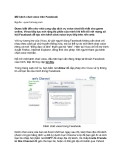
15
Networking
Issues
CERTIFICATION OBJECTIVE
•Understand Networking Issues
CertPrs8(SUN) / Sun Certified Programmer & Developer for Java 2 Study Guide / Sierra / 222684-6 / Chapter 15
Blind Folio 15:1
P:\010Comp\CertPrs8\360-6\CH15.vp
Saturday, November 26, 2005 2:51:40 PM
Color profile: Generic CMYK printer profile
Composite Default screen

2Chapter 15: Networking Issues
CertPrs8(SUN) / Sun Certified Programmer & Developer for Java 2 Study Guide / Sierra / 222684-6 / Chapter 15
CERTIFICATION OBJECTIVE
Understand Networking Issues
It is better to know some of the questions than all of the answers.
–James Thurber
Good questions outrank easy answers.
–Paul A Samuelson
If you don’t ask the right questions, you don’t get the right answers. A question asked in
the right way often points to its own answer. Asking questions is the ABC of diagnosis.
Only the inquiring mind solves problems.
–Edward Hodnett
Clever as you are, I bet you’ve figured out where this is heading…the Developer
exam is about you figuring out solutions to the problem/specification you’re given as
your assignment. So, any attempt on our part to offer suggested potential solutions
would, in our humble opinion, be defeating the whole point of the certification.
However, given that this is a book about preparing for the exam, we can offer you
questions. Things to think about. But we will start with a briefing on the core
technologies involved: Serialization, Sockets, and RMI. There’s far more to learn
about these than we could possibly say here, so we’re not even going to attempt to
give you a crash-course. We’re assuming that you’re familiar with the technologies,
and that you’ll do whatever research and experimentation you need to learn to use
them correctly. We will, however, do a simple review and then look at issues you’ll
need to consider when you build your project.
RMI and Sockets
As of this writing, the Developer exam expects you to know about networking.
Well, not just know but actually develop a network server that allows remote clients
to get information from a database (which you will also write).
Normally, building a simple network server presents you with two choices: RMI
or Sockets. If your assignment asks you to make a choice, rest assured that there is
not one right answer. You will need to think through the tradeoffs, make a choice,
and document your decision.
P:\010Comp\CertPrs8\360-6\CH15.vp
Saturday, November 26, 2005 2:51:40 PM
Color profile: Generic CMYK printer profile
Composite Default screen

One simple way to look at the difference is this:
Sockets are low-level, RMI is high-level.
In other words, RMI is a higher-level system that uses Sockets underneath. Whichever
you choose, you’ll need to be very comfortable with it, and you’ll need to justify
your choice.
Serialization
Somehow you’re going to have to move a client request—made on one machine—
across a wire to another machine. For your assignment, that “machine” might be
only a virtual machine running on the same physical computer, but the Big Issues
are the same whether the two machines (the client and the server) are on the same
physical box or not. Two JVM’s might as well be on two different boxes, with one
key exception—the classpath. If two instances of a JVM are started on the same
computer, they may well have access to the same stuff, and sometimes that masks a
problem with your application. So, whatever you do, test test test on two different
physical machines if you can.
What form is the client request? Well, remember from Chapter 11 when we
looked at the Horse Cruise system. A client might want to request a cruise based on
a certain date or horse criteria (easy horse, short horse, fast horse, etc.), or perhaps
both. Ultimately, that request can take any form before you ship it from the client
to the server; that’s up to you, but let’s say you’re going to use a String. That String
needs to be packaged up, shipped out, and land at the other end. When it’s picked
up at the other end, the other end has to know how to use it.
So we’re really looking at two issues: how to pack and unpack it for shipping, and
then how to make sure it makes sense to the program on the other end (the server).
The packing and unpacking is easy—Serialization. Whatever object(s) you ship over
the wire, they can be sent simply as flattened objects (serialized) and then they get
brought back to life (deserialized) on the other end, and once again become real objects
on the heap. So the object traveled from one heap to another. Well, it wasn’t even the
object that traveled, but a copy of the object. (We covered serialization in Chapter 6.)
OK, so the client makes a request for, say, a Horse Cruise on such and such a
date. Now what? We put the client request into a String, serialize it, and ship it out
(we haven’t yet said whether this would be through RMI or straight Sockets) and
the server picks it up, deserializes it, and uses it as an object. Now what? The client
obviously needs a result from the request. Whatever that result actually is, you’ll stuff
CertPrs8(SUN) / Sun Certified Programmer & Developer for Java 2 Study Guide / Sierra / 222684-6 / Chapter 15
Understand Networking Issues 3
CertPrs8(SUN) / Sun Certified Programmer & Developer for Java 2 Study Guide / Sierra / 222684-6 / Chapter 15
P:\010Comp\CertPrs8\360-6\CH15.vp
Saturday, November 26, 2005 2:51:40 PM
Color profile: Generic CMYK printer profile
Composite Default screen

it in an object (or group of objects) and ship it back following the same process—
serialize it, ship it to the client, client deserializes it and uses it in some meaningful
way (most likely, presenting the Horse Cruise search results in a GUI).
So now we know what form the request and result take (serialized objects), but we
still need to know how to ship it from point A to point B (in other words, from client
to server and from server to client). That leaves us with only one real question: do
we use Sockets or RMI?
Sockets
Given that Sockets are simply the end-points of a connection between two devices,
you aren’t limited to shipping only serialized objects over the wire. In fact, the
Socket has no idea what’s coming—it just sees a stream of bytes. When the server
gets the bytes, it’s up to your server code to figure out what those bytes are supposed
to mean. Are they in fact serialized objects? Then deserialize them…but in what
order are they coming over? The server needs to know. And if they’re not serialized
objects, the server needs to know exactly what is in those bytes, in exactly which
order, so it can do the appropriate read and get the bytes into some form a little
more useful (Strings, numbers, etc.). And for that, you’ll need a protocol. The client
code developer and the server code developer will have to get together in advance
and come to an agreement on what these bytes mean, in other words, how they’re
supposed to be interpreted. Of course, in the Developer exam, you’re writing both
the client and the server, so you only have to agree with yourself.
RMI
The beauty of RMI is that the protocol is already agreed on by both ends—it’s just
objects moving from one place to another (copied into the new location, but we’re
just going to say moved because it’s easier to think about). In other words, we’ve
already decided on the protocol for what the bytes mean, and the protocol is serialized
objects. And since we’ve established that, then the client and server don’t even have
to do the serialization/deserialization—RMI takes care of it.
The tradeoffs, then, are already shaping up: using Sockets lets you have whatever
protocol you want, but you have to do all the heavy lifting, while using RMI restricts
the protocol to serialization. But with that flexibility removed, RMI can do most
of the heavy lifting. By heavy lifting, we mean things like establishing the Socket
connections, packing up the bytes, sending an output stream from one place to
another, then receiving it and unpacking it and so on.
4Chapter 15: Networking Issues
CertPrs8(SUN) / Sun Certified Programmer & Developer for Java 2 Study Guide / Sierra / 222684-6 / Chapter 15
P:\010Comp\CertPrs8\360-6\CH15.vp
Saturday, November 26, 2005 2:51:41 PM
Color profile: Generic CMYK printer profile
Composite Default screen

RMI is much simpler than Sockets. But simplicity never comes for free, of course,
so it’s also a little slower. You have to decide in all of this which is most important,
but here’s a hint: think Team Work. Again, there’s no right answer; the assessor isn’t
going to prefer one over the other, because it depends on your goal and need (or in
some cases, all things being equal, just which you prefer). But whichever you choose,
you need to justify in your documentation (and possibly on the essay portion of the
exam) why you chose one over the other.
The rest of this document looks at some of the things you’ll need to think about
when implementing your solution. They are in no particular order, so don’t infer any
relative importance from the order in which they’re listed.
Questions to Ask Yourself
Ask yourself these questions as you design and implement your Exam solution.
■Serialization sends the entire object graph from point A to point B, for all
instance variables that are not marked transient. Is your object large? Do
you really need all that data to be shipped?
■Have you marked everything transient except the state you truly need on the
other end?
■Have you investigated leaving most of the state transient and then reconstructing
it by stepping into the deserialization process? The process of implementing
your own private readObject() method can help. (Think of a private
readObject() as kind of like a constructor, except instead of constructing
an object for the first time, the private readObject() is involved in
reconstructing the object following serialization.)
■Are the superclasses of your serialized class also serializable? If not, they’ll
need a no-argument constructor, so be certain that this fits your design.
■Do you have any final transient variables? Be careful! If you use blank finals,
you’re in big trouble because the variable will come back to life with a default
value since the constructor won’t run when deserializing an object. And since
it’s final, you’ll be stuck with that value.
■Have you thought about versioning issues? When an object is serialized,
remember, the class needs to be present at the location where the object is
being deserialized. What happens if the class has been modified? Will the
Understand Networking Issues 5
CertPrs8(SUN) / Sun Certified Programmer & Developer for Java 2 Study Guide / Sierra / 222684-6 / Chapter 15
P:\010Comp\CertPrs8\360-6\CH15.vp
Saturday, November 26, 2005 2:51:41 PM
Color profile: Generic CMYK printer profile
Composite Default screen











![Bài tập Tin học ứng dụng [nâng cao/cơ bản]](https://cdn.tailieu.vn/images/document/thumbnail/2025/20250824/shenkilltv@gmail.com/135x160/60111756087501.jpg)





